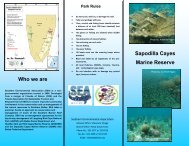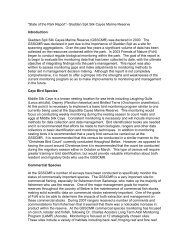gladden spit silk cayes marine - Southern Environmental Association
gladden spit silk cayes marine - Southern Environmental Association
gladden spit silk cayes marine - Southern Environmental Association
You also want an ePaper? Increase the reach of your titles
YUMPU automatically turns print PDFs into web optimized ePapers that Google loves.
GLADDEN SPIT SILK CAYES MARINE RESERVE<br />
The Gladden Spit and Silk Cayes Marine Reserve<br />
(GSSCMR) was declared in 2000. The Reserve was<br />
declared, in part, due to the importance of<br />
Gladden Spit as a site for fish spawning aggregations,<br />
which regularly attracts whale sharks during the<br />
months of April- June, making it a popular tourist<br />
destination.<br />
The <strong>marine</strong> reserve is a multi-use zoned Marine<br />
Protected Area, allowing for tourism as well as<br />
commercial fishing. Gladden Spit lies about 36km off<br />
the coast of Placencia Village, which sits at the tip of<br />
a long peninsula, the only long sandbar in Belize.<br />
The Gladden Spit and Silk Cayes Marine Reserve<br />
comprises of nearly 11,000 hectares (26,000 acres).<br />
SEA is responsible for the day to day management<br />
of this reserve. SEA, working closely with<br />
the Belize Fisheries Department, continues to ensure<br />
effective enforcement, biological monitoring<br />
and general management of this unique and important<br />
natural site.<br />
Photo by: Annelise Hagan<br />
PARK RULES:<br />
Park entrance fees apply year round, while the<br />
whale shark fees is applied 1 March to 31 July<br />
for entering the whale shark zone.<br />
Any person who wishes to conduct whale shark<br />
tours must have a valid tour guide<br />
license, dive master certification (for SCUBA),<br />
skin diver certification (for snorkelers) and a<br />
whale shark license issued by SEA.<br />
Any person engaging in a whale shark tour<br />
must abide by the Whale Shark Regulations<br />
and Guidelines<br />
* Do not touch, walk on or damage the reef.<br />
* Take your garbage with you.<br />
Dive, snorkel and fishing boats should<br />
maintain a distance of at least 200 feet<br />
between each other.<br />
* No gloves or fishing are allowed when<br />
SCUBA diving.<br />
* No destruction of natural habitat.<br />
* No anchoring on coral reefs.<br />
* No net fishing.<br />
* No spear fishing.<br />
All boats must use the mooring buoys where<br />
provided.<br />
* Read and abide by all regulations of the<br />
protected area.<br />
All local Fisheries, Wildlife, Forestry,<br />
Tourism, and Archeological Laws apply.




